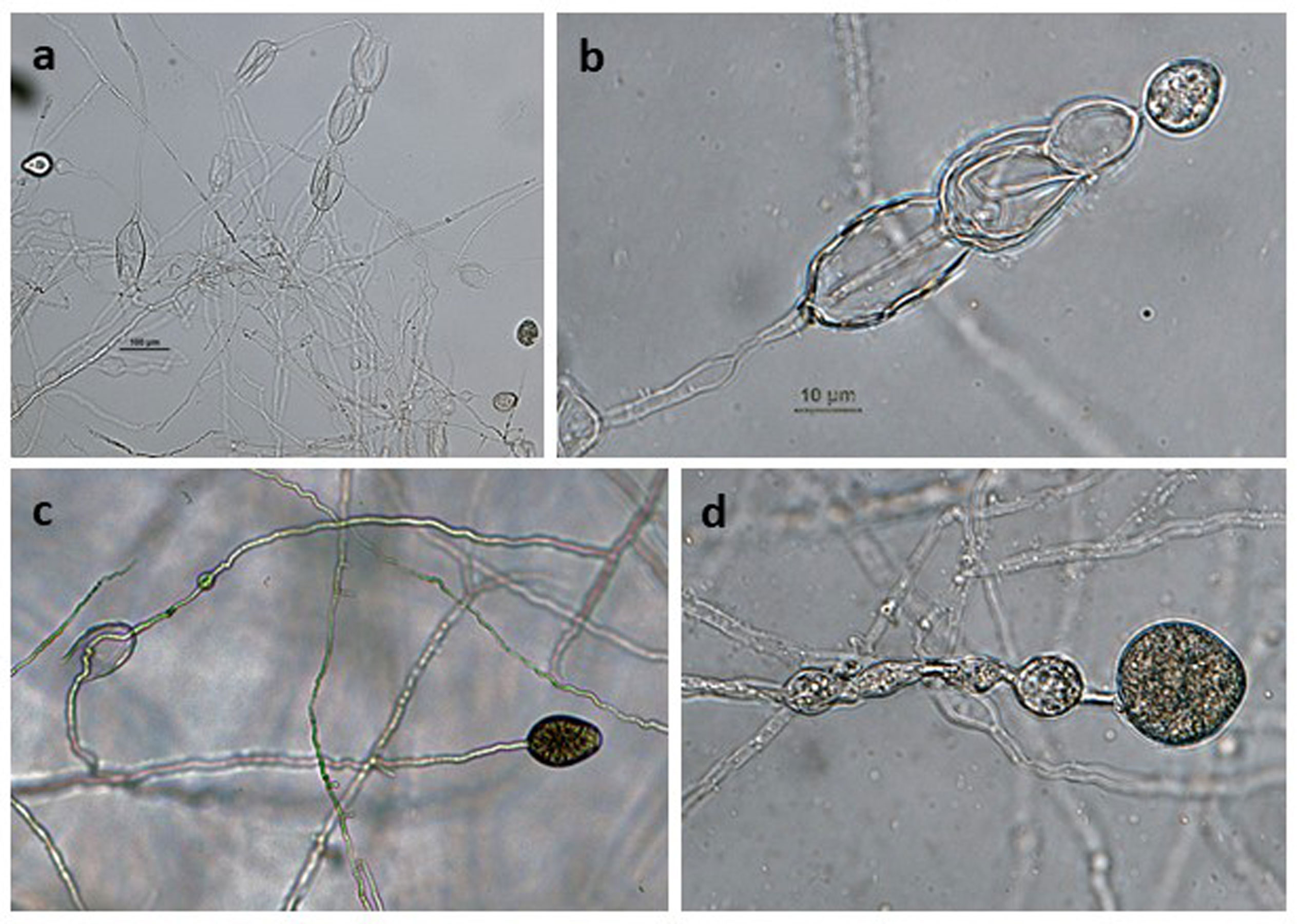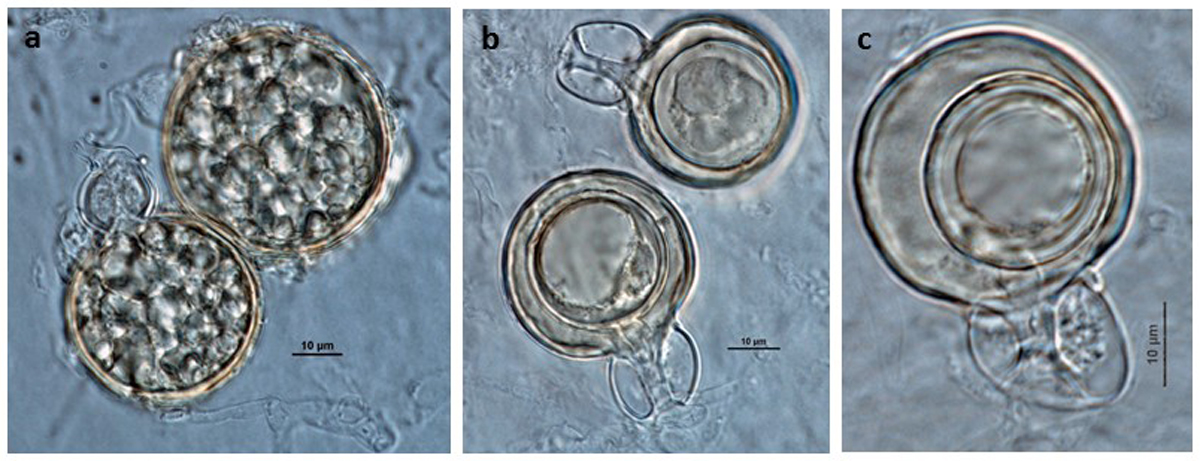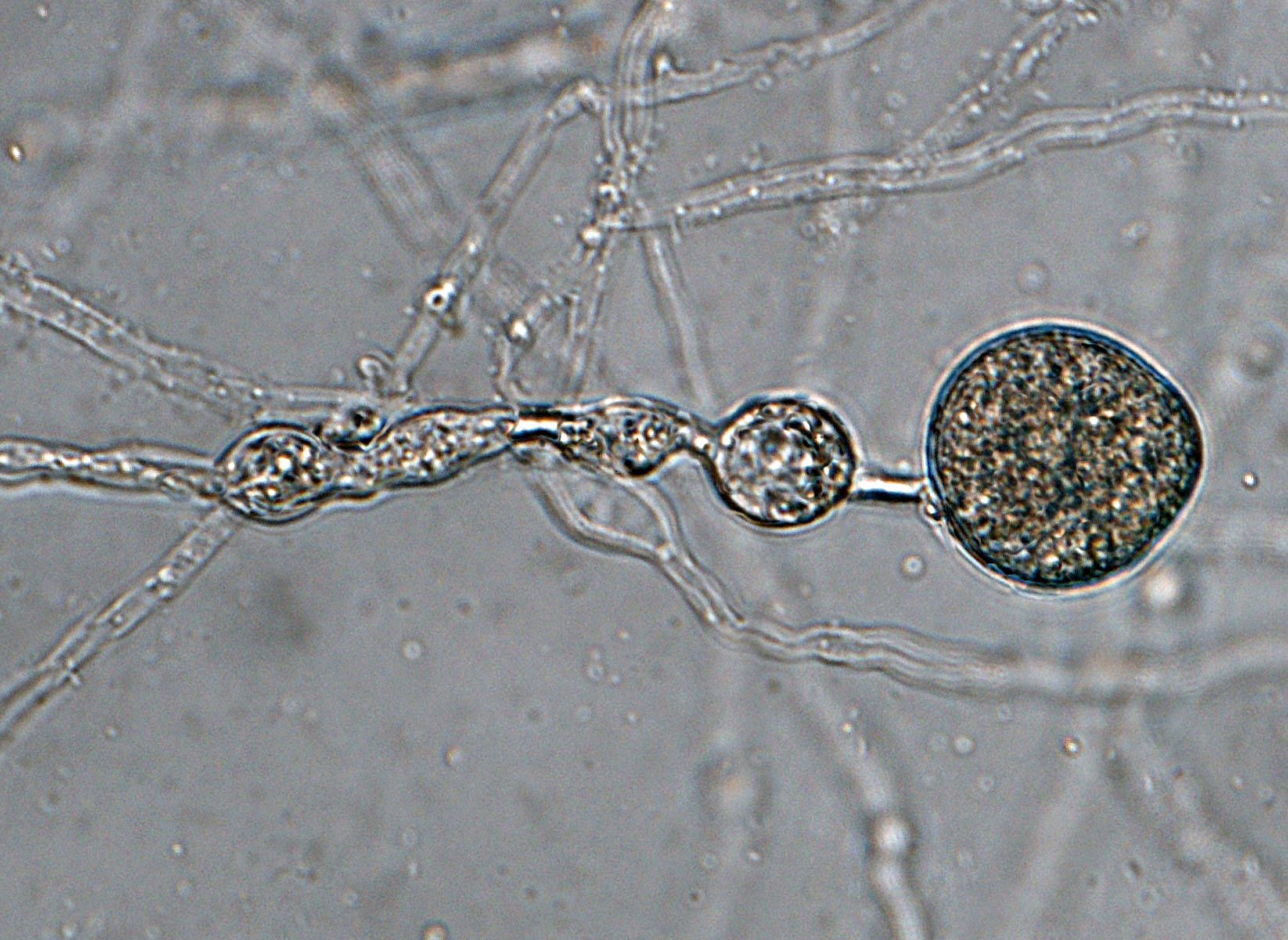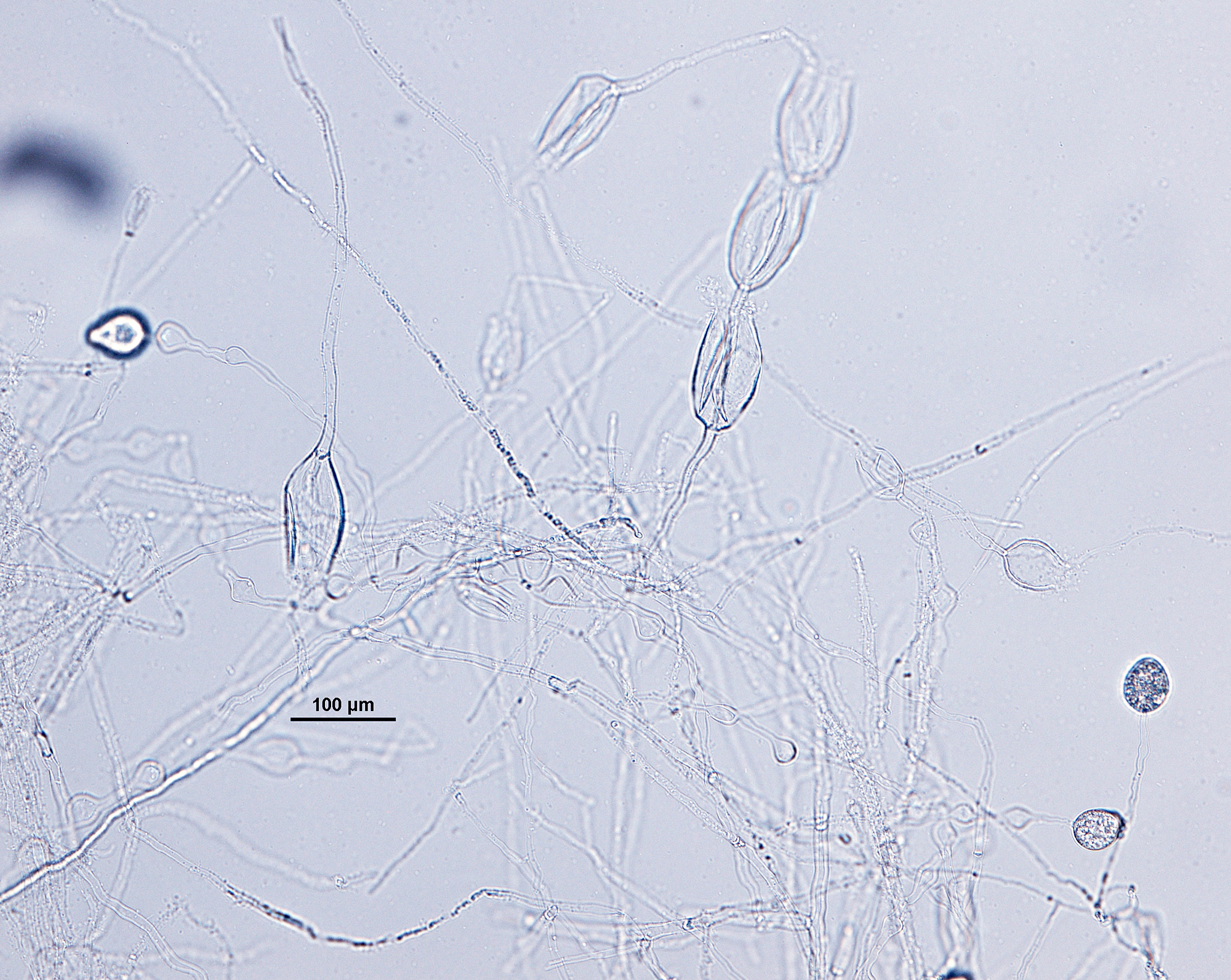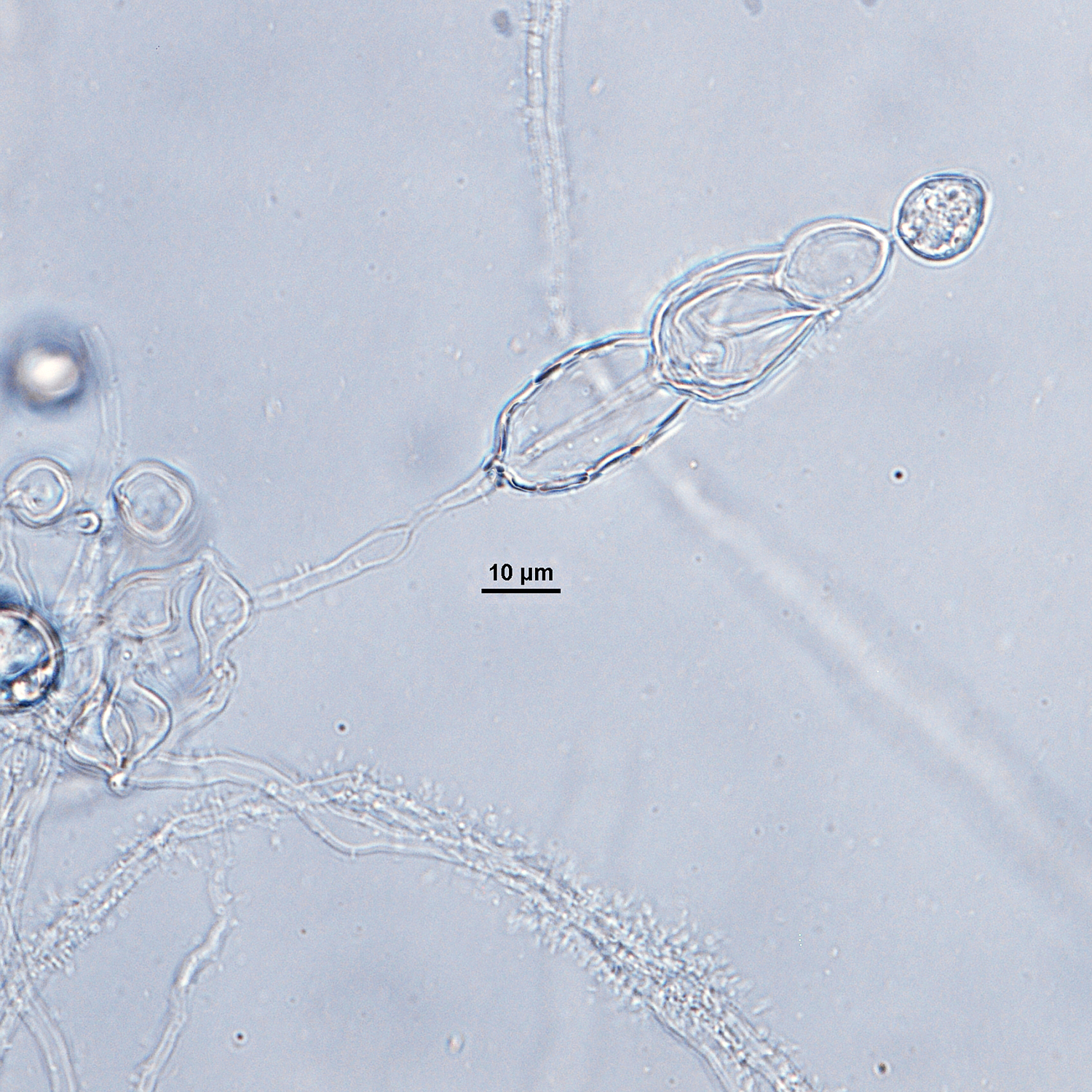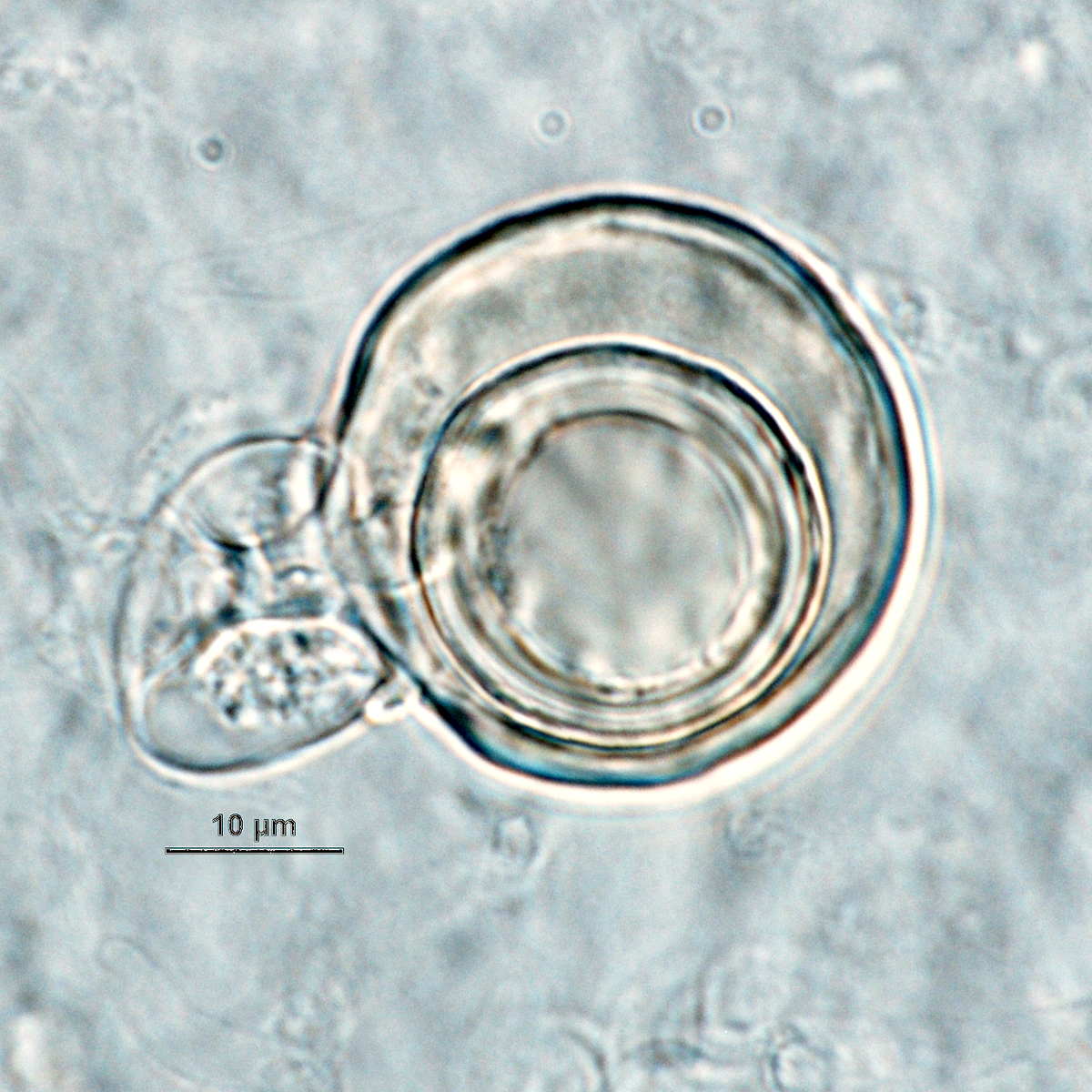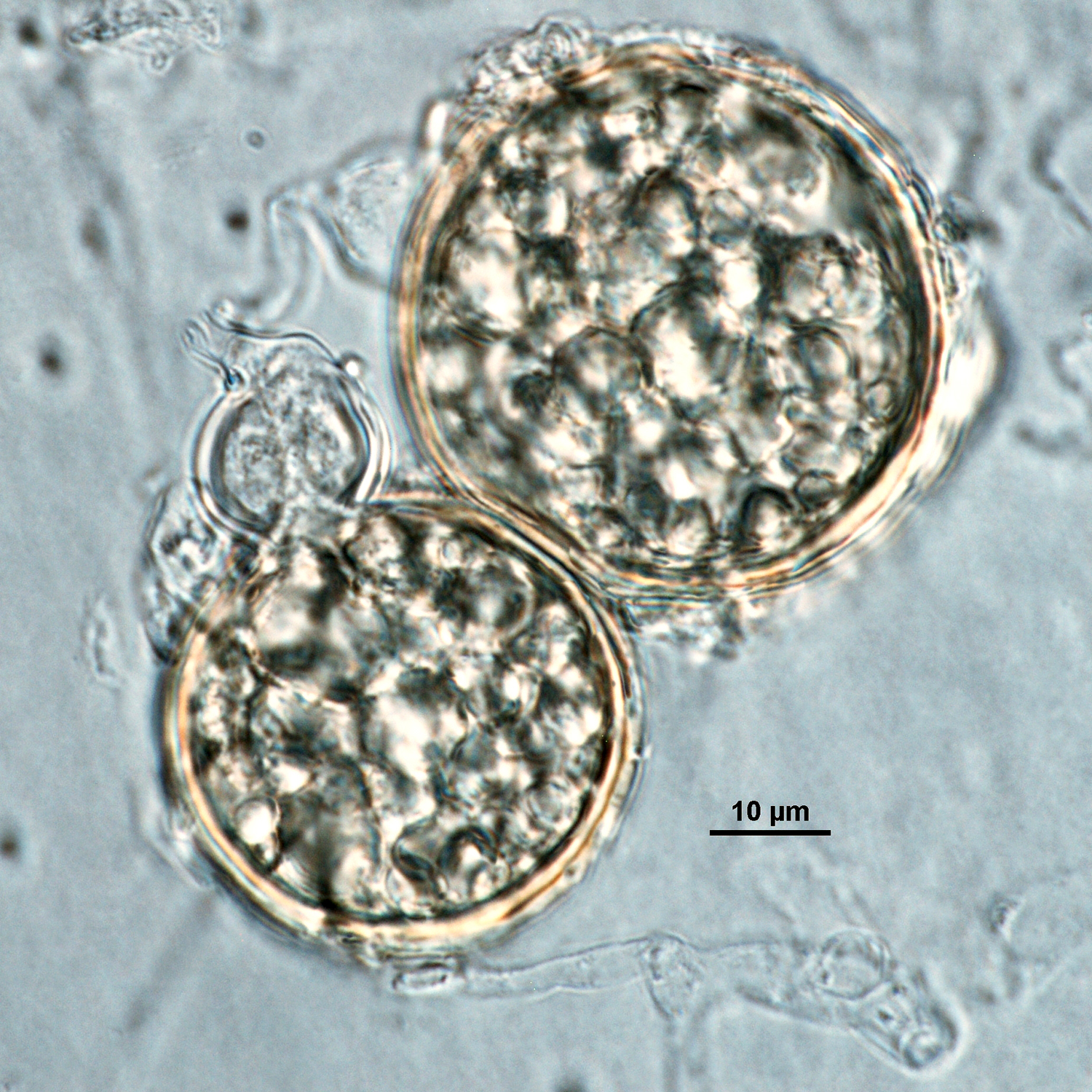Phytophthora cajani (in progress - Abad et al. 2023b)
|
Phytophthora spp. in subclade 7b: portion of the seven-loci ML phylogeny featuring the type cultures of 212 described species (by T. Bourret). Notice the position of P. cajani selected specimen ATCC 44388 = S&T BL 116. Gloria Abad, USDA S&T.
|
|
Phytophthora spp. in subclade 7b: Morphological Tabular key (PDF) and Tabular key legends (PDF) in IDphy2 KEY SECTION. Notice the data of P. cajani selected specimen ATCC 44388 = S&T BL 116. Gloria Abad, USDA S&T.
|
|
Phytophthora cajani, colony morphology after 7 days growth on (a) V8® agar (b) potato dextrose agar; photos by Yilmaz Balci, USDA-APHIS-PPQ |
|
Phytophthora cajani (CPHST BL 116) asexual phase (a–d): (a–c) sporangiophores with internal proliferations, (c, d) nonpapillate persistent sporangium originated in unbranched sporangiophores and showing hyphal swellings; photos by Gloria Abad, USDA-APHIS-PPQ. |
|
Phytophthora cajani (CPHST BL 116) sexual phase: (a) young oogonia with no differentiated oospore, (b-c) mature oogonia with amphigynous antheridia and markedly aplerotic oospores (compare with figures in original publication Amin et al. 1978); photos by Gloria Abad, USDA-APHIS-PPQ. |
|
Phytophthora cajani (CPHST BL 116) asexual phase: non-papillate persistent sporangium originated in unbranched sporangiophore and showing hyphal swellings; photo by Gloria Abad, USDA-APHIS-PPQ. |
|
Phytophthora cajani (CPHST BL 116) asexual phase): sporangiophores with internal proliferations; photos by Gloria Abad, USDA-APHIS-PPQ. |
|
Phytophthora cajani (CPHST BL 116) asexual phase: sporangiophores with internal proliferation. Non-papillate persistent sporangium originated in unbranched sporangiophores, hyphal swelling present; photo by Gloria Abad, USDA-APHIS-PPQ. |
|
Phytophthora cajani (CPHST BL 116) asexual phase: sporangiophores with internal proliferations; hyphal swellings also present; photo by Gloria Abad, USDA-APHIS-PPQ. |
|
Phytophthora cajani (CPHST BL 116) sexual phase: mature oogonium with amphigynous antheridium and markedly aplerotic oospore (compare with figures in original publication Amin et al. 1978); photo by Gloria Abad, USDA-APHIS-PPQ. |
|
Phytophthora cajani (CPHST BL 116) sexual phase: mature oogonia with amphigynous antheridia and markedly aplerotic oospores (compare with figures in original publication Amin et al. 1978); photo by Gloria Abad, USDA-APHIS-PPQ. |
|
Phytophthora cajani (CPHST BL 116) sexual phase: young oogonia with no differentiated oospores; photo by Gloria Abad, USDA-APHIS-PPQ. |
Name and publication
Phytophthora cajani K.S. Amin, Baldev & F.J. William (1978)
Phytophthora cajani K.S. Amin, Baldev & F.J. Williams ex Abad sp. nov. (2023)
Amin KS, Baldev B, and Williams FJ. 1978. Phytophthora cajani, a new species causing stem blight on Cajanus cajan. Mycologia 70: 171–176.
Nomenclature
from Amin et al. (1978)
Mycobank
Typification
Type: INDIA, causing stem blight on Cajanus cajan. Pure cultures have been deposited in the Phytophthora collection, Department of Plant Pathology, West Virginia University, Morgantown, U.S.A. under N516.
NOTE: Specimen N516 is lost at the Department of Plant Pathology, West Virginia University, Morgantown, USA.
Well-authenticated specimen selected by Gloria Abad: CPHST BL 116 = P3105 (WPC)
Selected specimen(s) in other collections
(SE) ATCC 44388 (MCI), N516, WPC P3105, S&T BL 116 (Abad), 45F7 (Hong), P2 (Erwin), JK 5 (Kannaiyan), p349 (Gallegly)
NOTES:
ATCC 44388 as Phytophthora drechsleri var. cajani
Yang et al. 2017 incorrectly indicates that specimen 45F7 is the type of the species.
Molecular identification
Voucher sequences for barcoding genes (ITS rDNA and COI) of the selected specimen (see Molecular protocols page)
Phytophthora cajani isolate CPHST BL 116 (= P3105 WPC) = ITS rDNA MG783386, COI MH136859
Additional sequences for molecular identification
Phytophthora cajani isolate P3105 = ITS rDNA HQ261515, COI HQ261262
Voucher sequences for Molecular Toolbox with seven genes (ITS, β-tub, COI, EF1α, HSP90, L10, and YPT1
(see Molecular protocols page) (In Progress)
Voucher sequences for Metabarcoding High-throughput Sequencing (HTS) Technologies [Molecular Operational Taxonomic Unit (MOTU)]
(see Molecular protocols page) (In Progress)
Sequences with multiple genes for selected specimen in other sources
- NCBI: Phytophthora cajani CPHST BL 116
- NCBI: Phytophthora cajani P3105
- EPPO-Q-bank: Phytophthora cajani
- BOLDSYSTEMS: Phytophthora cajani PHYTO157-10 P3105
Position in multigenic phylogeny with 7 genes (ITS, β-tub, COI, EF1α, HSP90, L10, and YPT1)
Clade clade:
a taxonomic group of organisms classified together on the basis of homologous features traced to a common ancestor
7b
Morphological identification
Colonies and cardinal temperatures
Colonies in CMA, V-8, and PDA with no distinctive pattern. Minimum temperature for growth 9°C, optimum 27–33°C, and maximum 36°C.
Asexual phase
SporangiaSporangia:
sac within which zoospores form, especially when water is cooled to about 10°C below ambient temperature; in solid substrates, sporangia usually germinate by germ tubes
non-papillate, persistentpersistent:
pertaining to sporangia that remain attached to the sporangiophore and do not separate or detach easily (cf. caducous)
, ovoidovoid:
egg-shaped, with the widest part at the base of the sporangium and the narrow part at the apex
, obpyriformobpyriform:
inversely pear-shaped, i.e. with the widest part at the point of attachment (cf. pyriform)
, ellipsoidellipsoid:
refers to a solid body that forms an ellipse in the longitudinal plane and a circle in cross section; many fungal spores are ellipsoidal or elliptic
, blunty ellipsoidellipsoid:
refers to a solid body that forms an ellipse in the longitudinal plane and a circle in cross section; many fungal spores are ellipsoidal or elliptic
(42–83 L x 29–46 W μm); showing internal, external, and nested proliferationnested proliferation:
a type of internal proliferation where a new sporangium develops successively inside the old sporangium after it has emptied
; originated in unbranched sporangiophores sometimes showing swellings. Hyphal swellings terminal and intercalaryintercalary:
positioned within a hypha (cf. terminal)
with finger-like projections. ChlamydosporesChlamydospores:
an asexual spore with a thickened inner wall that is delimited from the mycelium by a septum; may be terminal or intercalary, and survives for long periods in soil
absent.
Sexual phase
Homothallic. OogoniaOogonia:
the female gametangium in which the oospore forms after fertilization by the antheridium
smooth-walled (37–48 μm diam); antheridiaantheridia:
the male gametangium; a multinucleate, swollen hyphal tip affixed firmly to the wall of the female gametangium (the oogonium)
amphyginous, some with digital projections, some bicellular; oosporesoospores:
zygote or thick-walled spore that forms within the oogonium after fertilization by the antheridium; may be long-lived
apleroticaplerotic:
pertaining to a mature oospore that does not fill the oogonium; i.e. there is room left between the oospore wall and oogonium wall (cf. plerotic)
.
NOTES:
Original publication of Amin et al. (1978) indicates the presence of pleroticplerotic:
pertaining to an oospore that fills the oogonium (cf. aplerotic)
oosporesoospores:
zygote or thick-walled spore that forms within the oogonium after fertilization by the antheridium; may be long-lived
, however the figures show oogoniaoogonia:
the female gametangium in which the oospore forms after fertilization by the antheridium
with non-differentiated oosporesoospores:
zygote or thick-walled spore that forms within the oogonium after fertilization by the antheridium; may be long-lived
.
Isolate P3105 is indicated as heterothallicheterothallic:
pertaining to sexual reproduction in which conjugation is possible only through interaction of different thalli (i.e. different mating types) (cf. homothallic)
A1 type in the WPC. Isolate CPHST-BL #116 (Abad), a duplicate of P3105, is homothallichomothallic:
pertaining to sexual reproduction that can take place within a single thallus (i.e. self-fertile, non-outcrossing) (cf. heterothallic).
and produced oosporesoospores:
zygote or thick-walled spore that forms within the oogonium after fertilization by the antheridium; may be long-lived
in single culture in our laboratory (G. Abad 9/17/16).
Most typical characters
Phytophthora cajani is characterized by the presence of marked apleroticaplerotic:
pertaining to a mature oospore that does not fill the oogonium; i.e. there is room left between the oospore wall and oogonium wall (cf. plerotic)
oospores.
Specimen evaluated
Phytophthora cajani CPHST BL 116 (Abad) = P3105 [World Phytophthora Collection (WPC) California, USA]
Hosts and distribution
Distribution: Asia (India)
Substrate: stems, also on branches, petioles, leaves. Roots are not attacked.
Disease note: stem rot and blight
Hosts: Cajanus cajani (Fabaceae)
Retrieved January 29, 2018 from U.S. National Fungus Collections Nomenclature Database.
Quarantine status
USA: This species was listed as a species of concern during the 2009 Phytophthora prioritization project conducted by USDA APHIS PPQ CPHST PERAL (Schwartzburg et al.).
Additional references and links
- SMML USDA-ARS: Phytophthora cajani
- EPPO Global Database: Phytophthora cajani
- Forest Phytophthoras of the world: Phytophthora cajani
- CABI Digital Library: Phytophthora cajani
- Encyclopedia of Life (EOL): Phytophthora cajani
- Index Fungorum (IF): Phytophthora cajani
- Google All Phytophthora cajani
- Google Images Phytophthora cajani
- Google Scholar Phytophthora cajani
Fact sheet author
Z. Gloria Abad, Ph.D., USDA-APHIS-PPQ-S&T Plant Pathogen Confirmatory Diagnostics Laboratory (PPCDL), United States of America.

